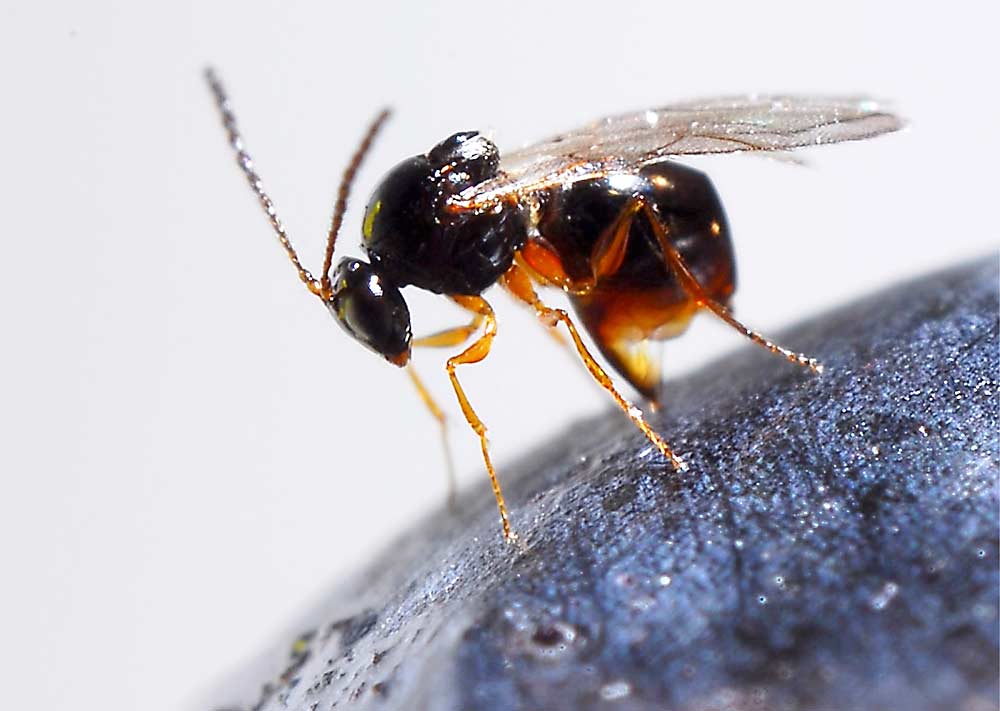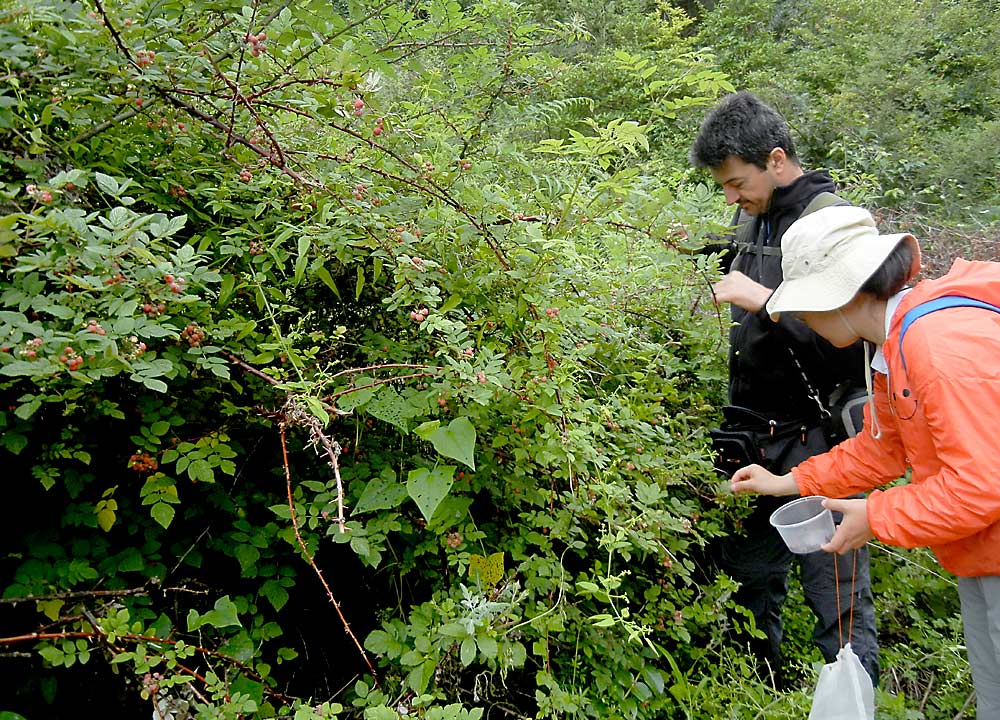
A new hope in the fight against spotted wing drosophila is on the horizon: tiny SWD-killing parasitoid wasps that should be ready for release next year.
Brought in from Eastern Asia, the wasps specialize in infesting the maggots of small fruit flies in the genus Drosophila — particularly SWD — according to Kim Hoelmer, entomologist and research leader at the Beneficial Insects Introduction Research Unit of the U.S. Department of Agriculture. He is helping University of California researcher and cooperative extension specialist Kent Daane prepare for the release of the wasps in fruit orchards, berry fields and other SWD-susceptible crops in prime growing regions throughout the United States. A wasp-identification tool to help growers and others distinguish one species from another, and therefore get a better handle on how well the released wasps are faring, is also in development.
The biocontrol committee of the North American Plant Protection Organization already granted its recommendation for release of the wasps, named Ganaspis brasiliensis, in the U.S., Canada and Mexico. The USDA’s Animal and Plant Health Inspection Service gave its approval for the release in the U.S., pending the review of the final public comments received this summer, Hoelmer said.
“We are hopeful that APHIS could grant its final OK soon enough to release the wasps in early fall this year, but if the approval takes longer, we expect the first releases to occur in spring,” he said. “As soon as the OK comes through, rearing of the wasps will ramp up and wasps will be delivered to cooperating growers in key production areas across the country.”
In each of those regions, Hoelmer and Daane are working with partners such as nurseries, academic research farms and commercial tree fruit, grape and berry growers interested in receiving some of these natural enemies. The plans for release at specific locations will depend on various factors, such as the supply of wasps available and the status of SWD populations in different crops and in different U.S. regions when wasps are ready for release, he said.
“We will want to make our initial releases into the best situations for wasps to locate hosts and become established locally,” Hoelmer said.
Then, they will monitor to see whether there are signs that Ganaspis is establishing, increasing and moving from the original release points.
“We never know with a project like this how quickly a natural enemy is going to establish and move. It depends on a lot of features of the insect, often that we don’t know until we have a chance to observe it in the field,” Hoelmer said. He also hopes some of the cooperators will start mass-rearing their own Ganaspis brasiliensis, to help speed the wasps’ spread.
Bringing in a biocontrol
The run-up to the anticipated release started with researchers spending several years surveying South Korea, China and other SWD-native regions for miniscule parasitoid wasps and then whittling down the prospects to find those that selectively attack and kill SWD. Three were top contenders but, following a battery of tests in quarantine laboratories, one became the top choice, Hoelmer said.

Meanwhile, Matthew Buffington, a research entomologist with the USDA’s Systematic Entomology Laboratory in Washington, D.C., worked to figure out exactly what kind of parasitoid wasp that top choice was. He is one of the few people in the world who has the expertise to delineate one species of these tiny wasps from another.
“For a candidate biocontrol agent to be authorized for release by APHIS, its species identity has to be uncontested or very clear, so my work fundamentally has been to try to figure out what is this species that the teams in South Korea and China have collected and gotten into quarantine,” Buffington said. “I could quickly figure out in this case what genus it was, but it took another two years to figure out what species it was.”
Buffington’s job now is to develop a way for anyone, including U.S. extension agents and the cooperating growers, to be able to distinguish Ganaspis brasiliensis from other SWD parasitoids, including native species. Native parasitoids may eventually adapt to exploit SWD as a host as well, so unless growers and extension agents can tell one species from another, they might attribute SWD declines to the biocontrol agent when a native species is actually at work. Worse, they might mistake an innocuous native wasp for Ganaspis brasiliensis and wrongly believe their crop is protected from SWD.
Researchers need to know if their prime parasitoid is “gaining a foothold in North America, or do we constantly have to be augmenting the population?” Buffington said.
To that end, Buffington is now working on a dichotomous key that will take users through a series of simple questions — augmented with helpful photos — so growers, extension agents and even home gardeners can quickly and easily identify Ganaspis brasiliensis, as well as just under a dozen general parasitoids of SWD in North America. Since the wasps are small, he noted, a microscope (or microscope app on a phone) will be useful. Buffington hopes to have his key available in time to coincide with the release of Ganaspis brasiliensis.
Once the key is available, Buffington anticipates that a wide range of information will begin pouring in as users find wasps that don’t exactly fit the key or are perhaps previously unidentified SWD parasitoids. The same thing happened when he worked on a key to the stink bugs, Buffington said.
“It was incredible to see how many putative biocontrol agents were actually out there once people had a key,” he said. “From a selfish standpoint of a taxonomist who just loves biodiversity and loves learning these little puzzles, I use (projects like this) as a way to get all this new biological information that’s typically impossible to get otherwise.”
That kind of information about both the SWD-attacking wasps and SWD’s wasp defenses helps with control efforts, he said. “This is a natural history story, too. It’s not just us vs. them,” Buffington said. “Everything is trying to eke out an existence, and if we can understand what they’re trying to do, it’s going to give us a step up.” •
—by Leslie Mertz






Leave A Comment